August 24th
For whatever reason I woke in the middle of the night and never got back to sleep. So after much tossing and turning the light finally inspired me to get up–that plus Lucky whining at me.
So most of the day was tedious, although I was able to get a few things under control. The rain yesterday only seemed to leak in one place, not an obvious solution, but next time it rains I’ll pay attention to it. I continued painting the fiberglass panels, which are as bad as fiberglass insulation in many ways, with dust that sticks to the skin and is like hundreds of little needles. The paint seems to lessen that to almost nothing. Painting also will lengthen the life, waterproof, and strengthen the light weight panels.
Although I’m weaning away from the panels on the roof, they are actually quite useful and a quick coat of latex paint will not only help make them more waterproof, but will bind up the fiberglass dust and make them easier to handle.
The idea is that these are a resource that may be useful in future if they are maintained well now. They go on quickly, providing some structure and waterproofing and have proven invaluable in past temporary applications.
At any rate, the paint has been lying around for years now and needs to be used up, so this seems like a good way to do it.
I also was busy taking inventory and cleaning up outside, and did some studying of the inner roof structure, planning the next phase of the roof stabilization. It is easier to do repairs and fasten things where they belong now than it is in the middle of a snow storm.
Anyway, I did figure out how to proceed with the rain gutter installation, and tomorrow morning I’ll be setting up 3 or 4 sections of the roof with gutters going to the cistern. There are also several panels in the roof now that need to be moved around a bit. The work I did the other day means that the sections are all level with each other and panels can overlap from one section to the next. While I was arranging the flat boards as rafters the panels got moved around a bit also, so some were out of place anyway and a couple good winds could cause some problems.
In the cleanup I was not only bringing order to chaos, but getting rid of stuff, and the next trip to town I’ll have several boxes of stuff for the dump. I also was able to empty several of the big plastic containers and make a little more floor space here and there.
August 25, 2017
A little better sleep last night, I discovered the reason I was having trouble sleeping was because it was getting too cold, and in recent cleanups I had removed all the winter blankets to air them out. About midnight I went into the spare room and found a light summer blanket and slept till 5.
Cutting up trees around the upper pond, cleaning left over debris away from the edge and moving it all to the high water mark after the dam is finished this fall. Listening to one of the Permaculture course videos I was reminded that regulations in this over regulated world can have lots of ways around them.
On a small scale, pond dams can often be classified as erosion control devices, ponds can also be used in irrigation management and it is all true. This upper dam may in fact never hold water all the way through the seasons, but it certainly helps control erosion.
The fish pond likewise started out as a driveway crossing, and the fact that it holds water is a happy accident.
Anyway, wearing a jacket and leather gloves was a great way to work since it avoids so many cuts. And I made a pretty good dent in many of the chain saw cuts that needed to be made.
One of the first things I did on the house was get out another gallon of mistinted paint and paint more of the fiberglass panels. The first color was a dark pink, this made it much whiter. I’ve heard Seattle grey is the uniform color they make from all the old paint that is recycled there. I will likely add another gallon or two of whatever else I can find. There’s still lots of panels to paint, and I’m also painting those that are not in use.
I’ve been working on repairing the wheel of a lawn mower I just got back, and after two days using a wire brush and penetrating oil at periodic intervals the nut finally broke free with no damage to the wheel or the nut. A couple of really big washers to help stabilize the broken metal on the mower body, a few bits of tinkering to flatten and straighten the torn bits, and I was able to use one of the remaining holes to mount the wheel.
I started out filling the gas tank with diesel fuel accidentally, so had to dump that out and then refill with gasoline. I didn’t worry about getting all of the diesel out because that simply acts as a carburetor cleaner – or at least that’s what my uncle told me. He said during the gasoline rationing in world war 2 they use to regularly mix their gas with diesel to stretch their ration. He said except for the extra smoke it worked just fine.
Anyway, once I got the mower started I didn’t want to stop it, so I spent the next half hour cutting paths through the tall grass. If the wheel is still in good shape there’s a meadow to cut that is starting to see some volunteer trees moving in.
I was up on the ladder and the roof, and will go up once more to see if I can get those boards cut right on the first section so I can install a fascia board. We have at least two more days forecast as even cooler weather, perfect for that sort of work. I also found the section of gutter that adapts to the downspout, so at some point I’ll be ready to power through the details and install it, but for now I’m content taking my time making small steps getting ready.
There’s also always a bit or two that needs to be carried to the trash or put in the right place. The object is to continue to create space and get rid of junk.
August 26, 2017
Last night before dusk I went ahead and cut the secondary rafters to allow the placement of a fascia board, quite a lovely sight to see the ends tied together in a more professional manner, and the next step will be extending the fascia on at least three more sides.
Since the work needs to be completed on this water collecting feature, I’m already thinking about how to cut the angles for the rain gutters. With non traditional designs like this one all the fittings need to be custom made. I have some experience with this from cutting rain gutters for the octagon, and expect these to be reasonably straightforward, and likely I can manufacture the critical cuts and joining on the ground, and have only one or two angles to assemble from the ladder. I can already hear the next batch of rainwater running down the spout into the cistern.
After the trip to town I’ll be looking forward to cutting grass, fitting fascia boards, cutting trees, clearing debris, and cutting and fitting gutter angles. But for right now I think it’s time to walk around and find rain gutters and hangers so I know if I need to buy anything.
August 31, 2017
A lot has happened since I last wrote. Fascia and gutters on 6 sides, general cleanup and work on pond sites.
Today however was a real dooser although it started out very straight forward clearing more debris from the high pond expansion area, then little bits and pieces of cleanup, visit to a friend, then decided to cut the grass around the walnut tree at my neighbors house.
After most of the critical grass under the tree had been cut things got ugly and ended up with me being chased a considerable distance by ground nesting yellow jackets and leaving the lawn mower there running.
The first thing I did immediately after getting back to the house was take a couple eye dropperfuls of echinacea extract internally. Then I showered and decided more decisive therapeutic action might be required.
I remembered hearing that sometimes being stung over and over can cause more severe reactions each time and with the recent history of a similar incident a couple weeks before I was somewhat nervous that something more serious might happen. So I gathered up my blender and a load of fresh plantain leaves and headed back to my neighbor’s house.
We mixed in a bit of water and liquified the plantain leaves, then he went over my back and arms and with bandaids secured the plantain poultices in place. I think he counted 10 bandaids after most of the stings were covered. One sting in the middle of my head and another on my eyebrow were deliberately left without bandaids.I noticed on the way back home that the lawn mower had finally run out of gas, but no way I was going after it yet.
I did stop and look a bit to try and see where the swarm seemed to be, but left my hat on the ground where it fell off when I was running, about 15 feet away from the nest. That was still closer than I wanted to get. They get a visit tonight after dark and I’ll get the mower and if possible pour a couple gallons of urine on the nest. I may wait however for the next rain storm to make sure they are not flying.
Later I noticed that where I was stung on my eyebrow was very sore, so I put some of the leftover poultice we prepared in my hand and held it on my eyebrow for 15-30 minutes and notice now as I write that most of the ache/pain has gone from it. There’s also a spot on top of my head that could probably do with a bit more poultice as well.
September 1, 2017
Well, all the owies have turned into itchies or gone away completely, and this morning I took my first hot shower since I shut down the rocket stove in the Spring.
The outside temps were cool this morning, and with most of the heat going into the water there should be no problem with overheating inside now. Plus I decided some hot water might relax some of the tension generated by all the recent work and stings my body has been through.
The rocket stove performed perfectly up to specs. It has been two years in this configuration, although each year I think I want to add some insulation to the heat riser, clean and do a visual inspection inside the barrel. For now it seems to be in good condition, and the only thing I might do is rebuild the fire box.
Repairs and maintenance are easy on the clay portions of the stove, and I keep a bucket of fresh sifted clay nearby just for the odd occasion when the mood strikes and I decide to smooth a surface or repair a crack. Right now there are some non critical cracks around the fire box because it originally was built with a glass front.
Even though the glass was from a fireplace enclosure, it was not up to the heat generated in the stove, and quickly shattered. I had replaced the glass with fire brick, and did a quick patch around the edges with clay, but those repairs are a bit under the weather now and showing signs of wear.
The fire box takes the most abuse of any part of the stove, and while not the hottest part of the stove, temps there can reach 700 degrees F.
The copper coil that heats the water really does need to be upgraded, but I will save that project for a more peaceful time when I can give it my full attention.
I am still toying with the idea of waiting for next year to rent the back hoe again.
If I do that it will mean some sort of intermediate work on the low gully dam to bring the whole length high enough to push excess water out the spillway. Seems like it may be time to do some observation and thinking about possibilities.
No time like the present!
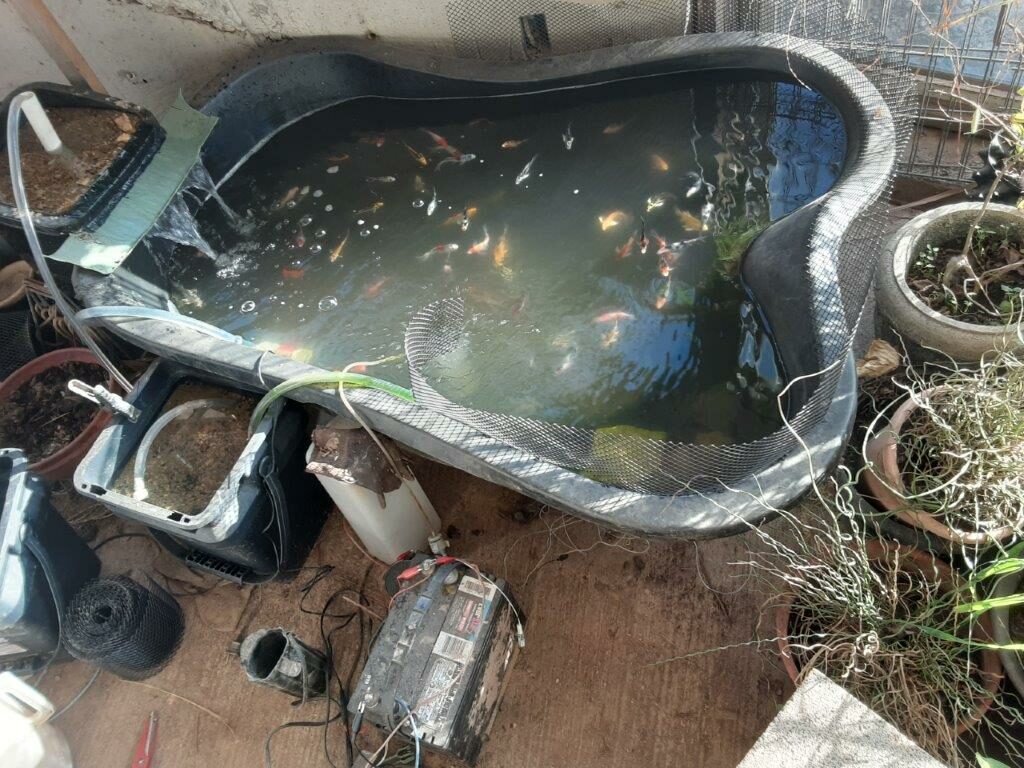
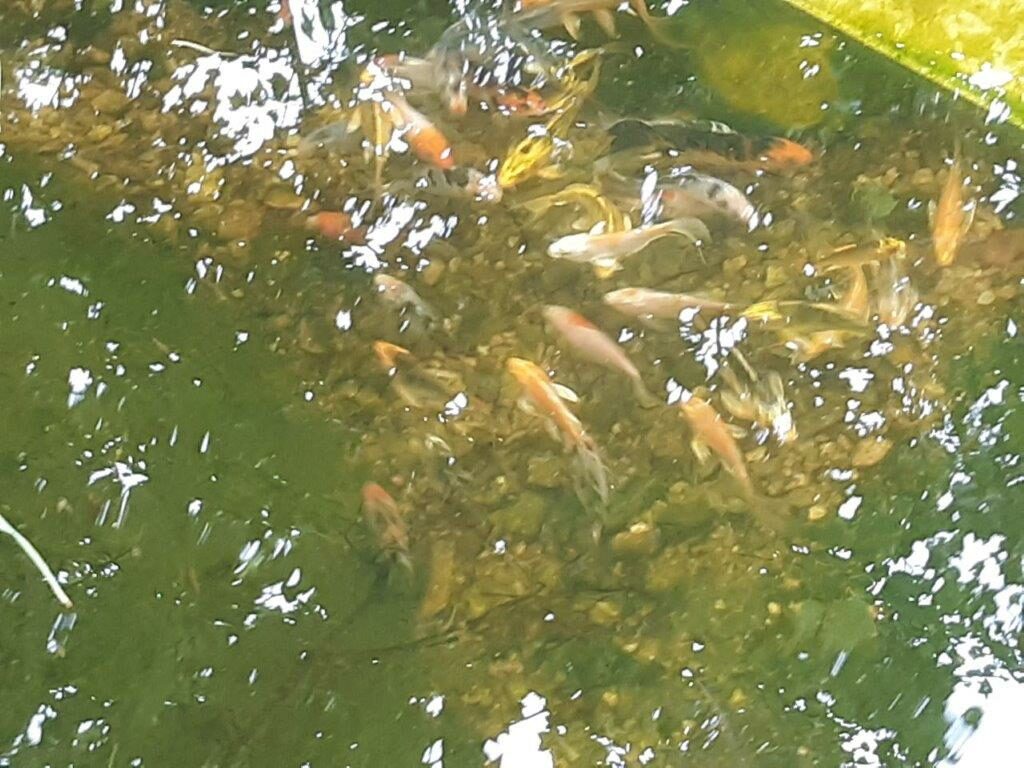
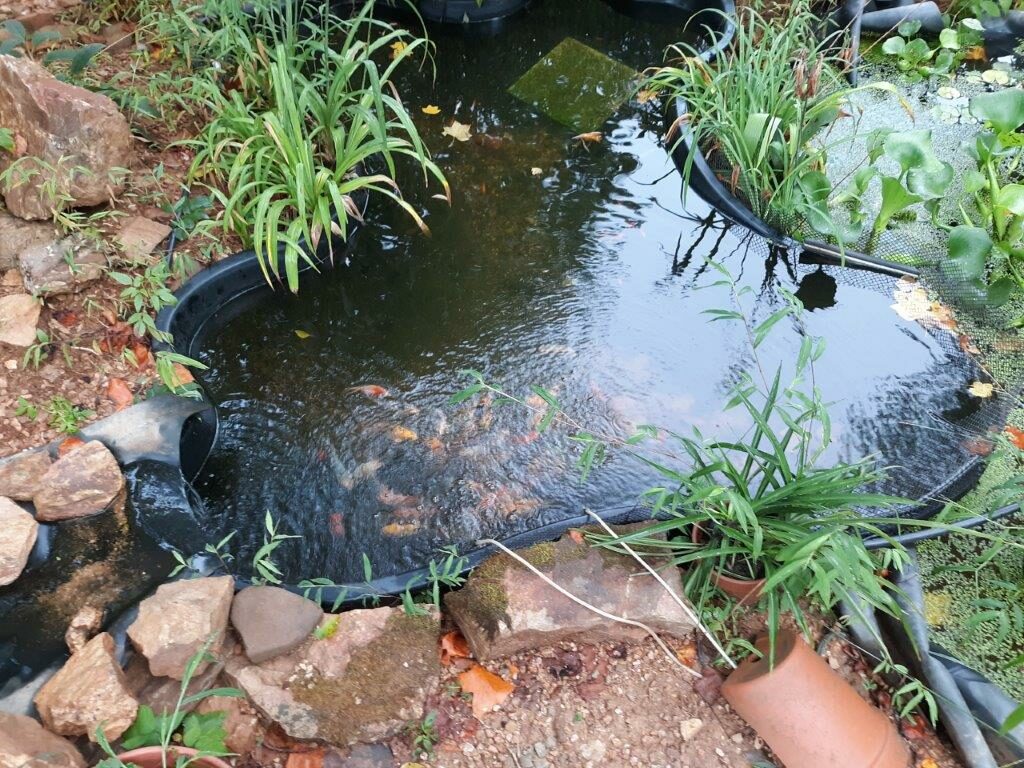
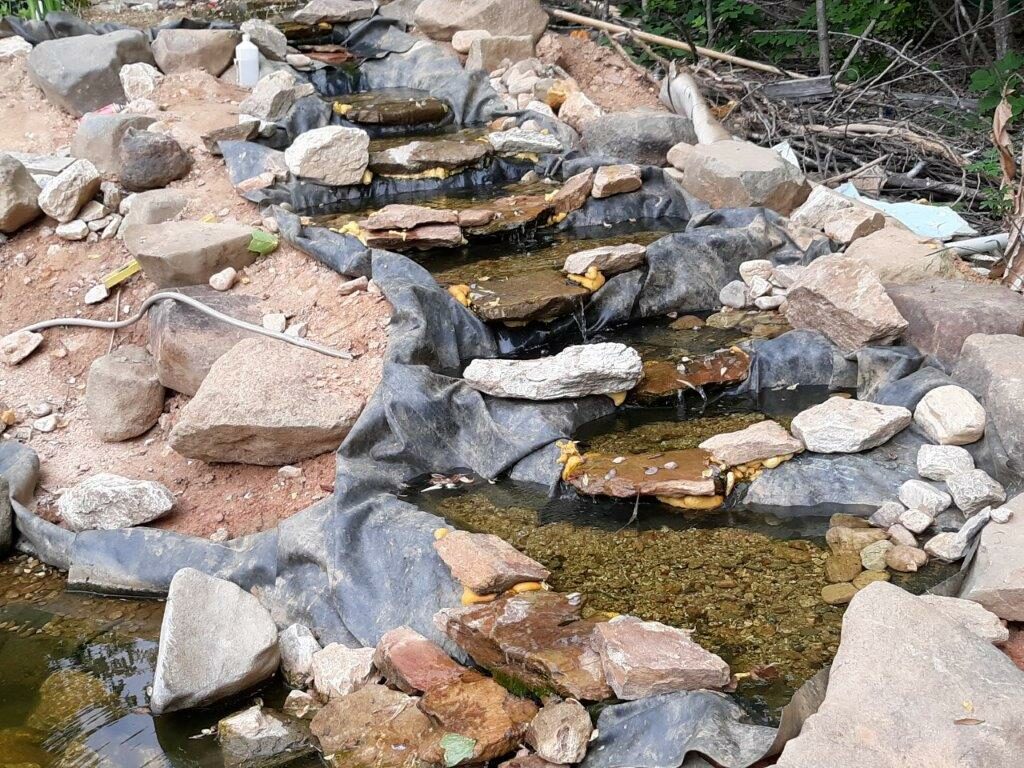
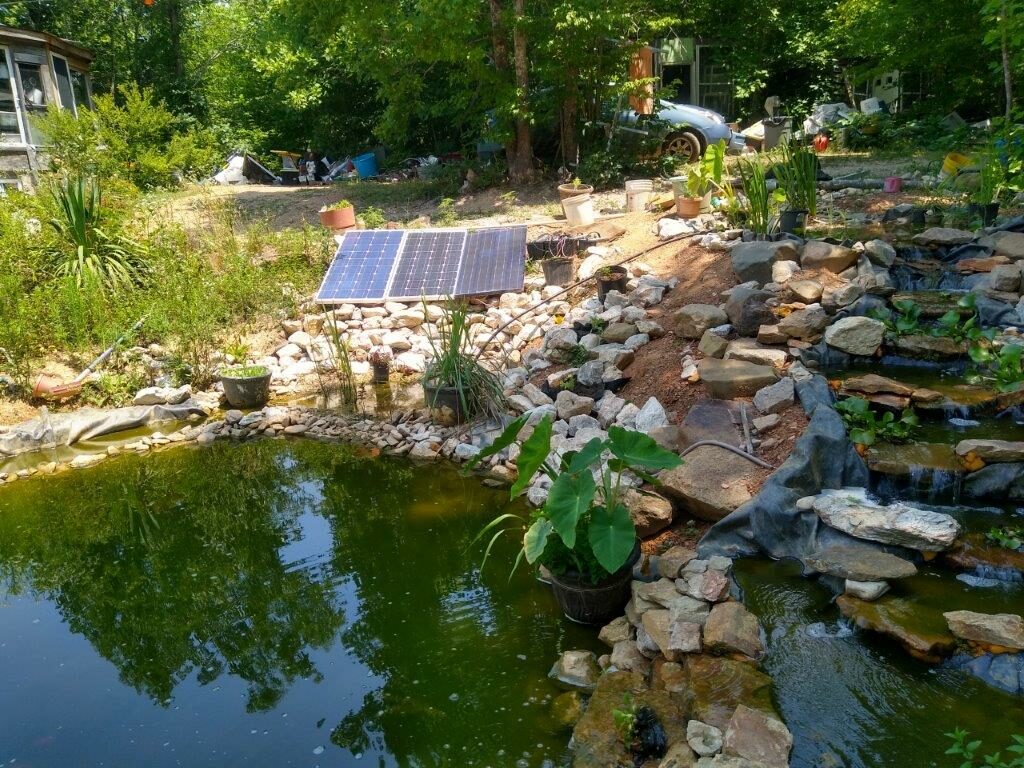
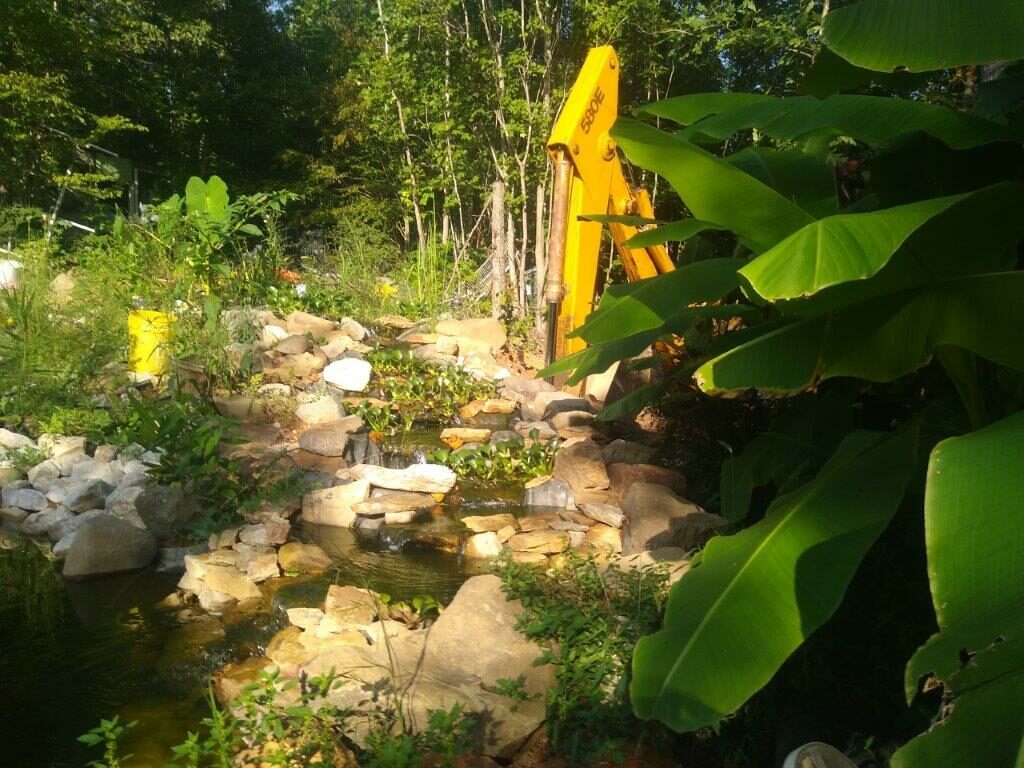
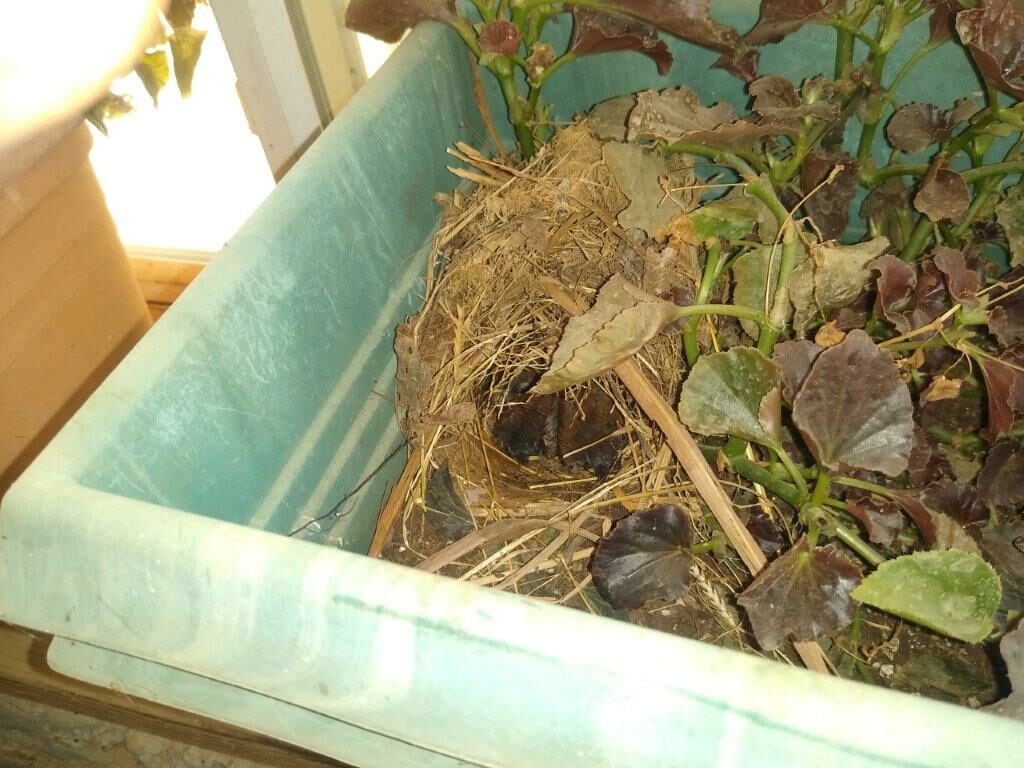
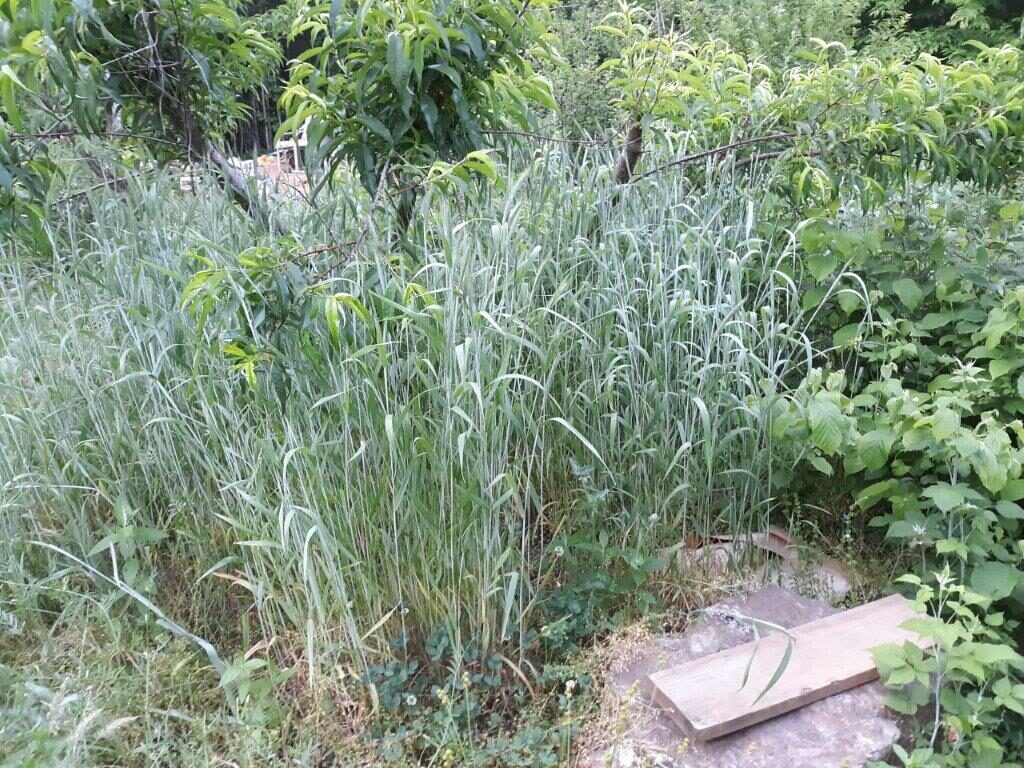
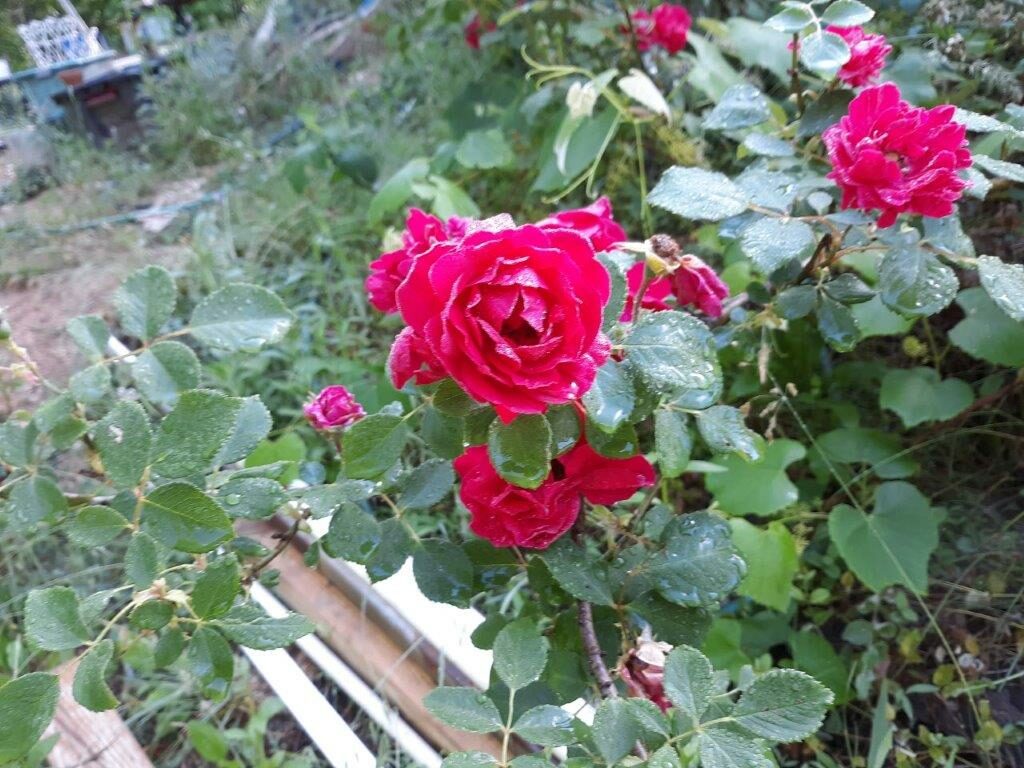
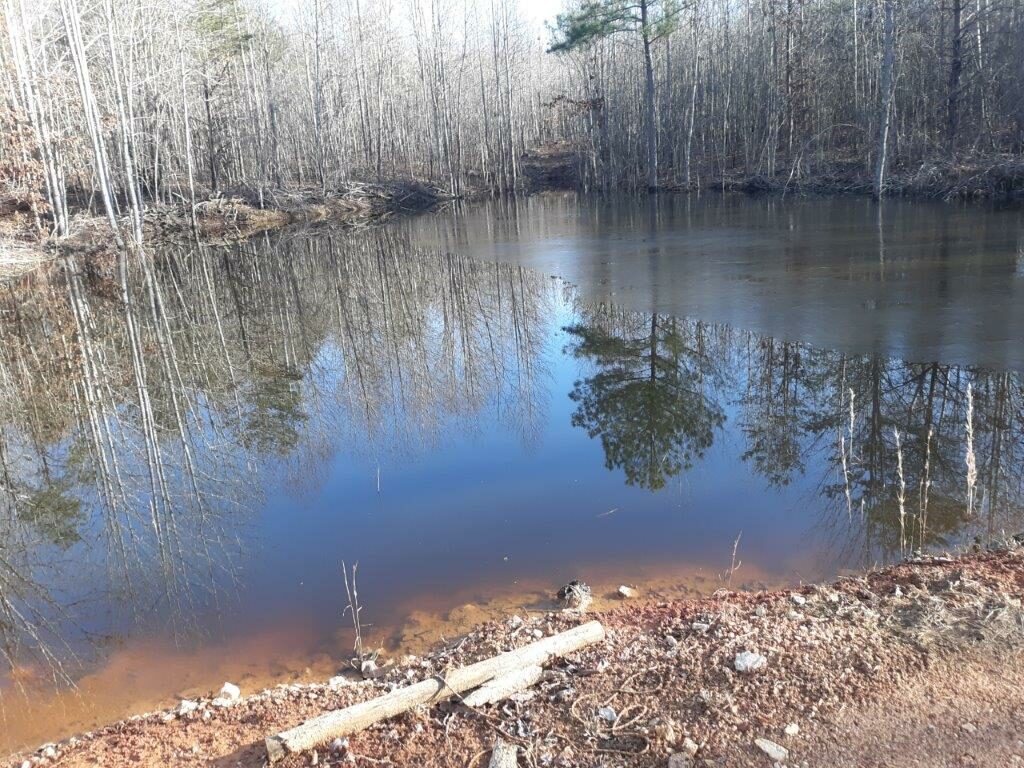
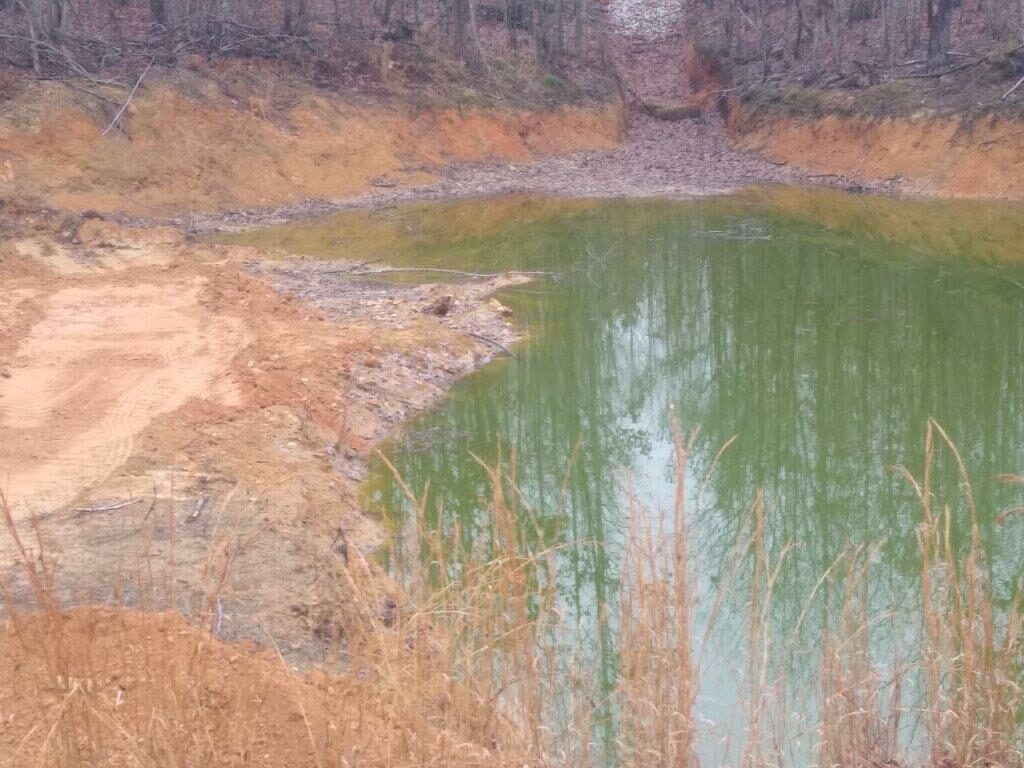
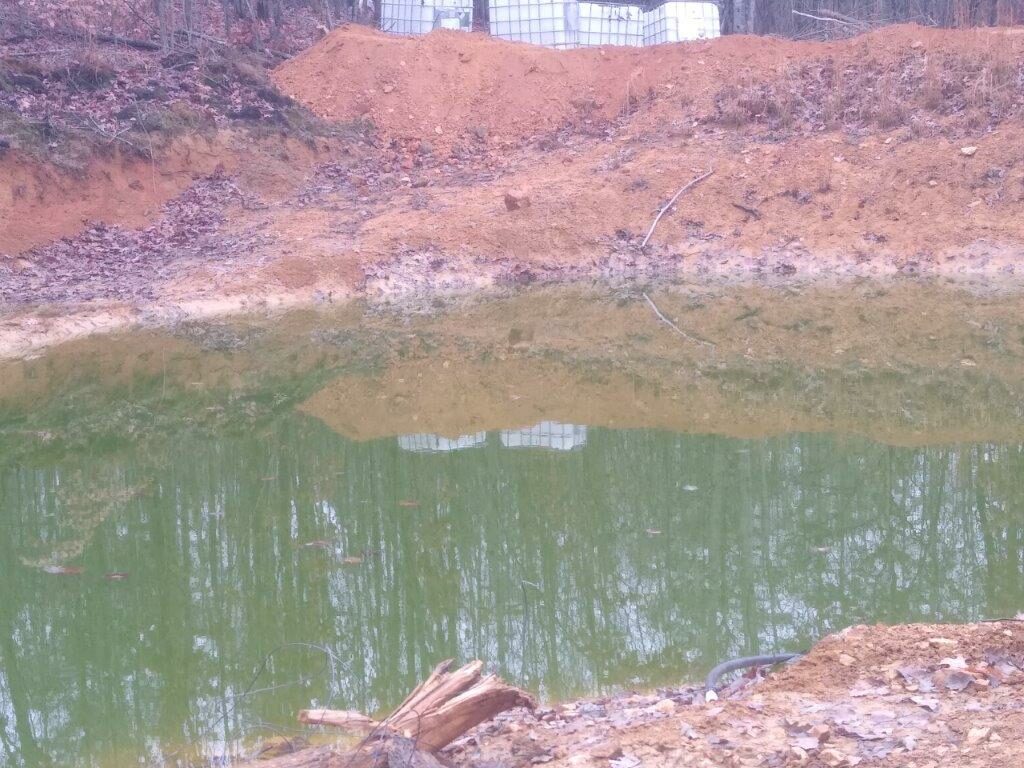
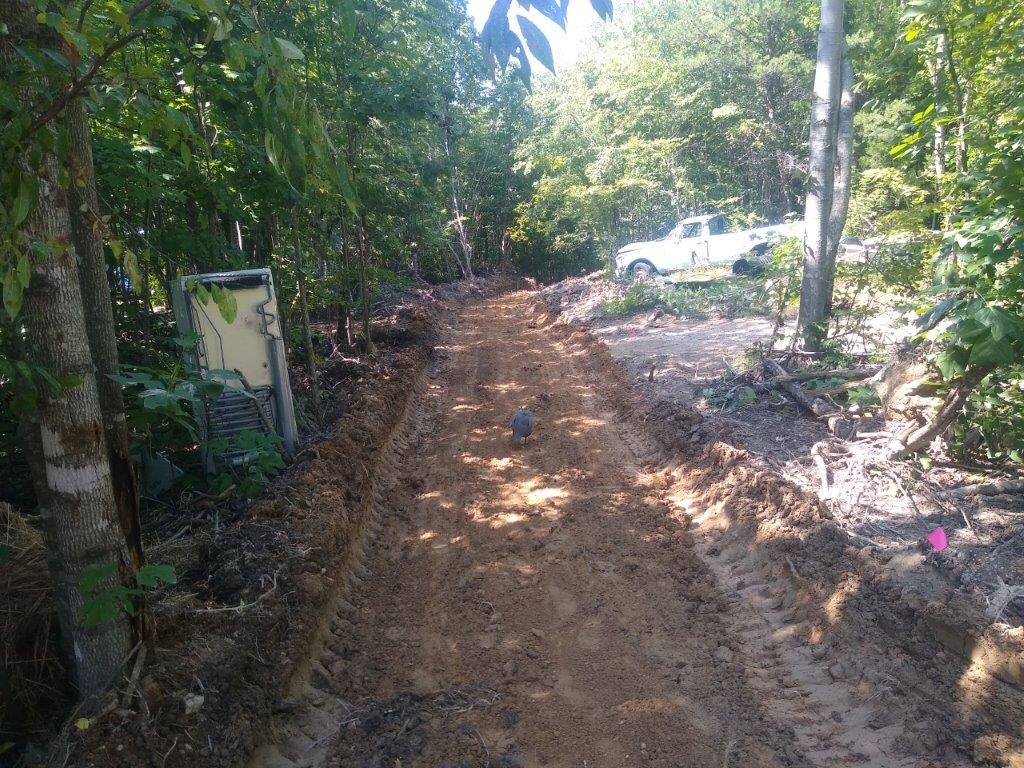
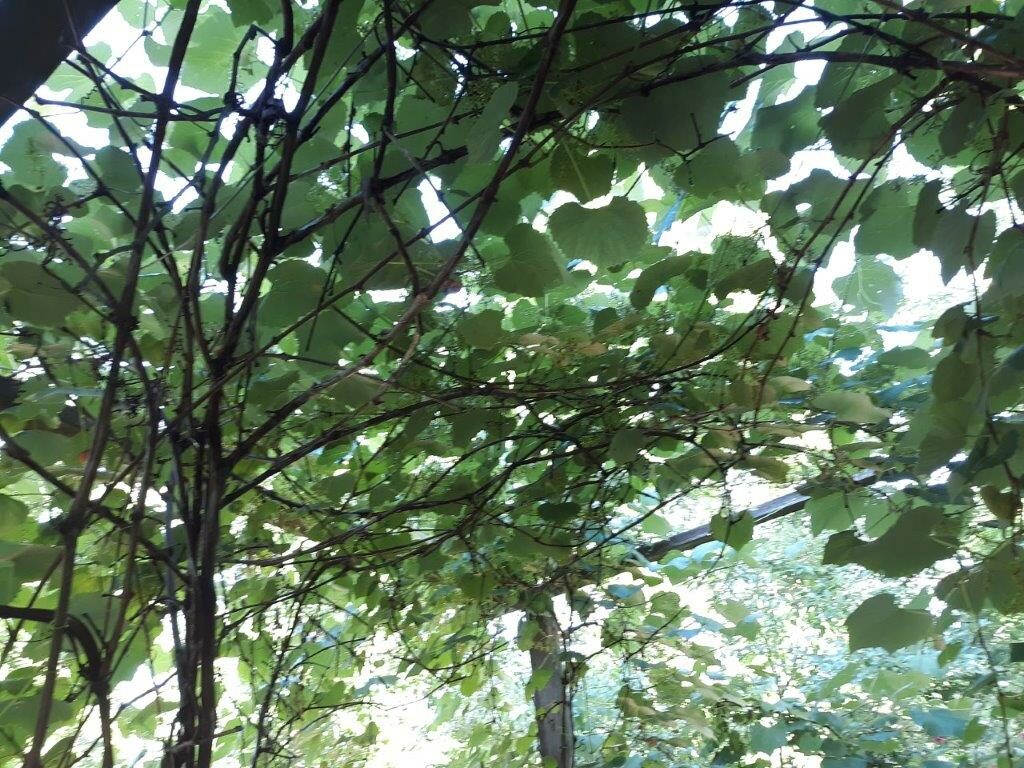
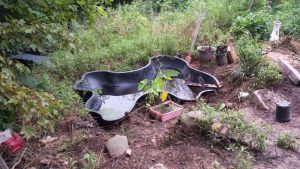 At the top of the kitchen garden, this new pond is a salvage that I had to repair using plastic welding techniques. I tried to create a clay based pond
At the top of the kitchen garden, this new pond is a salvage that I had to repair using plastic welding techniques. I tried to create a clay based pond 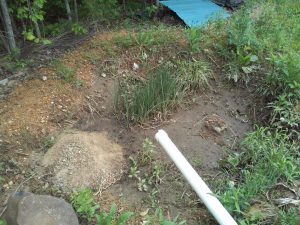 in this place, but all last year it filled many times and never held water very long, even with lots of clay added to try and seal it. In general, I would never spend money on a Plastic prefabs, but when the price is low and I can repair it, the energy audit becomes much better! I’m also finding that for smaller ponds a liner of some sort is probably going to be the only way to go.
in this place, but all last year it filled many times and never held water very long, even with lots of clay added to try and seal it. In general, I would never spend money on a Plastic prefabs, but when the price is low and I can repair it, the energy audit becomes much better! I’m also finding that for smaller ponds a liner of some sort is probably going to be the only way to go.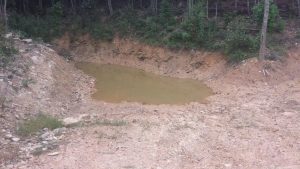
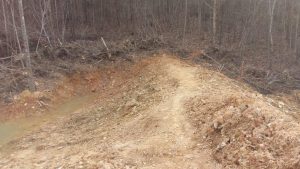 The water actually started to fill the pond from the bottom, and that water came in as a blue green color,
The water actually started to fill the pond from the bottom, and that water came in as a blue green color, 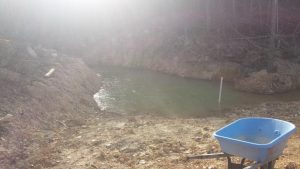 but run off filled it most of the way, and that water was heavy with sediment
but run off filled it most of the way, and that water was heavy with sediment 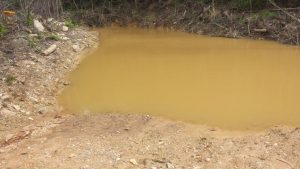 then it took weeks of hand labor to get it the rest of the way to this height.
then it took weeks of hand labor to get it the rest of the way to this height.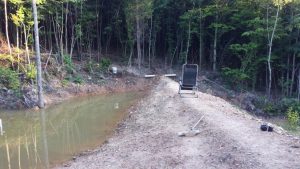
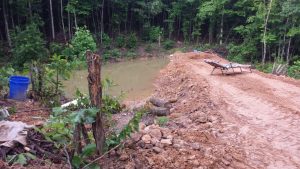
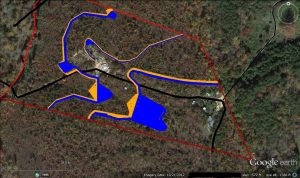 This is an overview of the half of the property(red boundary). Difference in elevation is about 100′ from lower right to upper left and the two ponds at the bottom of the picture are all in the same gully that runs downhill from right to left. The small pond pictured just above those two
This is an overview of the half of the property(red boundary). Difference in elevation is about 100′ from lower right to upper left and the two ponds at the bottom of the picture are all in the same gully that runs downhill from right to left. The small pond pictured just above those two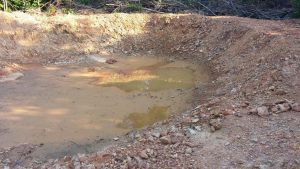 has never really held water yet, but it does show signs of improving it’s water retention. This may change over time with organic matter and better integration of the swale, but that requires completion of the Low Gully Dam.
has never really held water yet, but it does show signs of improving it’s water retention. This may change over time with organic matter and better integration of the swale, but that requires completion of the Low Gully Dam.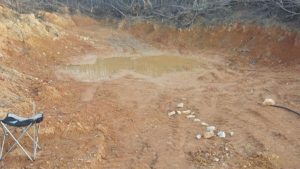
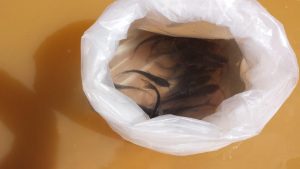 that survived the winter at this water level (only a couple feet deep). This year they are over a foot long!
that survived the winter at this water level (only a couple feet deep). This year they are over a foot long!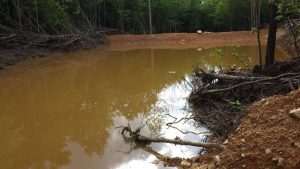
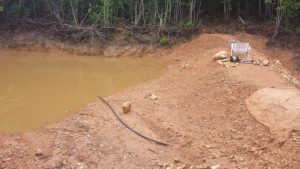 while it may not be obvious in the picture, the dam has been holding back the flood with a wall thickness of only 2 feet or less at the top
while it may not be obvious in the picture, the dam has been holding back the flood with a wall thickness of only 2 feet or less at the top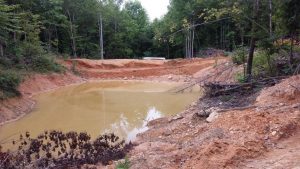
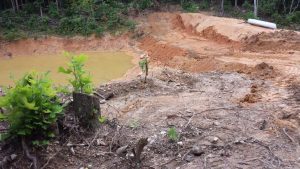 but as this picture shows, the added mass will more than double the width of the dam wall, and the actual compaction will also be much better.
but as this picture shows, the added mass will more than double the width of the dam wall, and the actual compaction will also be much better.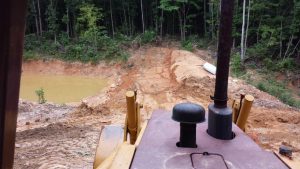
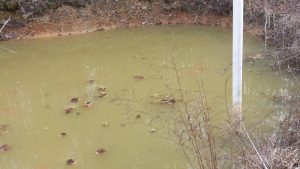 Goldfish pond (not shown on plan), a bit murky after a rain
Goldfish pond (not shown on plan), a bit murky after a rain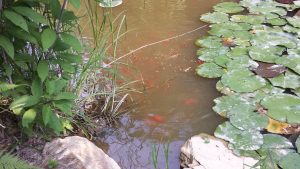 A close in snapshot of the gold fish pond. This was created when the driveway was put in about 15 years ago, and has boasted hundreds of fish, all descended from a few 38 cent babies from Walmart. There have also been crayfish, herons, and one huge snapping turtle that have all visited the pond at different points. Needless to say I try to discourage the heron(s) and snapping turtles with varying degrees of success.
A close in snapshot of the gold fish pond. This was created when the driveway was put in about 15 years ago, and has boasted hundreds of fish, all descended from a few 38 cent babies from Walmart. There have also been crayfish, herons, and one huge snapping turtle that have all visited the pond at different points. Needless to say I try to discourage the heron(s) and snapping turtles with varying degrees of success.